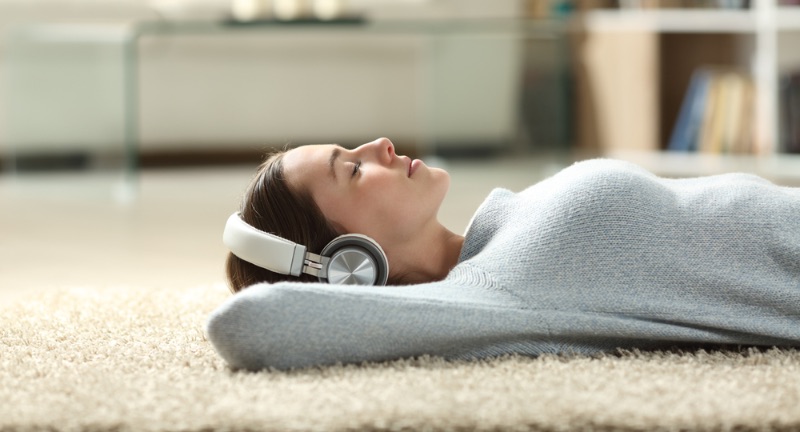EXPLORE
31 Reasons Why Headphones Are Bad For You
Published
2 months agoon

Shutterstock
Headphones are something many people can not live without, from jamming out to your favorite playlist to zoning out in a crowded subway. But, just like eating a whole pizza in one sitting, sometimes we overdo it without realizing the consequences. Too much headphone action can mess with your ears, mental health, and even your sleep schedule. So, before you blast your next banger, let’s chat about the not-so-fun side effects of going all-in with those little ear buddies. Don’t worry, we’re here to help you vibe safely and soundly!
Hearing damage

Shutterstock
Excessive use of headphones, especially at high volumes, can cause permanent damage to the hair cells in your inner ear. These cells are responsible for transmitting sound signals to the brain, and prolonged exposure to loud sounds can overwhelm them. Over time, this can lead to irreversible hearing loss, making it difficult to hear everyday sounds. The damage is cumulative, meaning each exposure to loud music or noise increases the risk of permanent harm.
Ear infections

Shutterstock
Wearing headphones for extended periods can create a warm and moist environment inside your ears, which encourages bacterial and fungal growth. This can lead to ear infections, which are often painful and require medical attention. The risk is heightened if you share headphones with others or do not clean them regularly. Frequent infections can result in hearing complications and discomfort.
Noise-induced hearing loss

Shutterstock
Listening to music or audio at high volumes through headphones can cause noise-induced hearing loss (NIHL). This occurs when sound levels are too high for the ear to handle, leading to permanent damage over time. The intensity of the sound and the length of exposure determine the degree of hearing loss. Protecting your ears by lowering the volume and taking breaks can help mitigate this risk.
Tinnitus

Shutterstock
Excessive headphone use can contribute to the development of tinnitus, a condition characterized by ringing or buzzing in the ears. This is often caused by exposure to loud noises, which can damage the auditory nerve. Tinnitus can be temporary or permanent, and in some cases, it can be debilitating. Reducing the volume and duration of headphone use can help prevent or reduce the severity of tinnitus.
Headaches

Shutterstock
Wearing headphones for long periods can lead to tension headaches, often caused by the pressure on the head or ears. Over-ear headphones can put pressure on the temples, while in-ear headphones may cause discomfort deep in the ear canal. Both types can result in headaches, especially if the headphones are worn too tightly or for too long. Taking breaks and adjusting the fit can alleviate these symptoms.
Pressure-related discomfort

Shutterstock
Prolonged headphone use can cause pressure-related discomfort, especially with over-ear or on-ear models. The pressure can build up on the outer ear, leading to soreness or irritation. In-ear headphones can also cause discomfort as they push against the ear canal for extended periods. To reduce this discomfort, consider taking regular breaks and switching between different types of headphones.
Earwax buildup

Shutterstock
Using headphones frequently can contribute to earwax buildup, especially with in-ear headphones. The earwax is pushed deeper into the ear canal, preventing natural drainage and sometimes leading to blockages. This can result in discomfort, hearing issues, or even infections. Regularly cleaning your headphones and allowing the ear to breathe can help prevent this problem.
Reduced situational awareness

Shutterstock
Wearing headphones can significantly reduce your situational awareness, making it difficult to hear surrounding sounds. This can be dangerous, especially when walking, cycling, or driving, as you may not hear approaching vehicles or other important environmental cues. Lowering the volume or using open-ear designs can improve awareness while still allowing you to enjoy your audio. It’s crucial to stay alert to your surroundings for safety reasons.
Neck strain

Shutterstock
Extended headphone use, particularly with large over-ear models, can cause neck strain. The weight of the headphones on your head and the tension in your neck from the constant pressure can lead to discomfort. This may also contribute to poor posture over time. Adjusting the fit, taking breaks, and stretching can help reduce neck strain associated with headphone use.
Ear fatigue

Shutterstock
Listening to audio for long periods can lead to ear fatigue, where the ear becomes sensitive to sound or discomfort. This is often the result of continuous pressure on the ear or prolonged exposure to high-volume sounds. Ear fatigue can make it difficult to focus or enjoy audio, and it may lead to temporary hearing issues. Taking regular breaks and adjusting the audio settings can help prevent ear fatigue.
Overheating of ears

Shutterstock
Overheating of the ears can occur when wearing headphones for extended periods, especially with over-ear or closed-back models. The material covering the ear can trap heat and moisture, leading to discomfort and potential skin irritation. In extreme cases, it can even cause sweating, which can contribute to bacterial or fungal growth. Choosing breathable materials and allowing your ears to rest can help reduce overheating risks.
Poor posture

Shutterstock
Wearing headphones for extended periods, particularly while working or studying, can lead to poor posture. The tendency to lean forward or tilt your head to get a better audio experience can strain the neck and back muscles. Over time, this can result in chronic pain and discomfort. Practicing good posture and adjusting your seating can help mitigate this issue.
Dependency on loud volumes

Shutterstock
Regularly listening to audio at high volumes can make you increasingly dependent on loud sounds for an enjoyable experience. This can train your ears to prefer louder audio, potentially leading to hearing damage over time. The habit of cranking up the volume can be difficult to break, and it can become a cycle of increasing sound exposure. Being mindful of volume levels and gradually lowering the sound can help prevent dependency.
Jaw discomfort

Shutterstock
Wearing headphones for long periods can cause jaw discomfort, particularly with over-ear models. The pressure from the ear cups on the sides of your head can extend to the jaw area, leading to tension or soreness. This can also contribute to temporomandibular joint (TMJ) pain, which affects the jaw and surrounding muscles. Adjusting the fit and taking regular breaks can help alleviate jaw discomfort.
Increased stress levels

Shutterstock
Listening to loud music or audio through headphones can increase stress levels, particularly when combined with loud, aggressive music genres. The brain processes high-volume sounds as a stressor, which can elevate heart rate and trigger anxiety. Over time, exposure to stressful audio can lead to heightened emotional sensitivity. Opting for calming sounds and moderating volume levels can help reduce stress during headphone use.
Social isolation

Shutterstock
Wearing headphones frequently, especially in social situations, can contribute to social isolation. By blocking out external sounds, you may miss conversations or social cues, which can make you feel disconnected from those around you. This can create a barrier between you and others, leading to a lack of meaningful social interactions. Setting aside time for face-to-face communication can help maintain connections while enjoying your audio.
Impaired communication

Shutterstock
Wearing headphones while in conversations can impair communication, as you may not hear important parts of the dialogue. Even slight distractions can lead to misunderstandings or misinterpretations. This can cause frustration for both you and the person you’re communicating with. It’s important to be mindful of your surroundings and remove headphones when engaging in important conversations.
Disruption of natural ear acoustics

Shutterstock
Headphones disrupt the natural acoustics of your ears, as they block the ear canal and alter how sounds are processed. This can lead to a less accurate perception of sound and may make it difficult to gauge the loudness or quality of different sounds. The artificial sound environment can contribute to discomfort and disorientation in some individuals. Returning to natural hearing by taking breaks from headphones can help restore your auditory experience.
Increased risk of accidents

Shutterstock
Wearing headphones while walking or cycling can significantly increase the risk of accidents. With the ability to block out environmental sounds, you may not hear oncoming vehicles, sirens, or other important warnings. This lack of awareness can result in dangerous situations that could otherwise be avoided. Staying aware of your surroundings by lowering the volume or removing headphones when necessary can help reduce accident risks.
Allergic reactions to materials

Shutterstock
Some individuals may experience allergic reactions to the materials used in headphones, such as rubber or certain metals. These reactions can cause itching, rashes, or swelling, particularly in areas where the headphones come into contact with the skin. This can lead to discomfort and irritation, and in some cases, more severe allergic responses. Choosing hypoallergenic materials or using headphone covers can help minimize this risk.
Long-term auditory nerve damage

Shutterstock
Prolonged exposure to loud sounds through headphones can lead to long-term damage to the auditory nerve. The nerve, responsible for transmitting sound signals to the brain, can be permanently damaged by consistent exposure to high volume levels. This damage can lead to hearing difficulties and permanent hearing loss. Limiting headphone use and maintaining safe volume levels can help prevent this long-term damage.
Reduced blood circulation in the ear

Shutterstock
Wearing headphones for long periods can reduce blood circulation in the ear area, especially with tight-fitting models. The restriction of blood flow can lead to discomfort and potential long-term issues, including ear fatigue and nerve problems. It’s important to ensure that headphones are not too tight and that breaks are taken to promote healthy blood circulation. Adjusting the fit and choosing more comfortable headphones can help maintain ear health.
Balance issues

Shutterstock
Prolonged headphone use, especially with in-ear models, can potentially affect your balance. The inner ear plays a crucial role in maintaining equilibrium, and pressure from the headphones can impact the vestibular system. This may result in dizziness or a sense of imbalance, particularly during or after prolonged listening sessions. Limiting headphone use and taking breaks can reduce the risk of balance-related issues.
Interference with hearing aids

Shutterstock
Headphones can interfere with hearing aids, making it difficult to use both devices simultaneously. The sound from the headphones may disrupt the amplification provided by the hearing aid, diminishing its effectiveness. This can cause frustration for users who rely on hearing aids for clear sound. It’s important to use headphones designed for hearing aid compatibility if you have a hearing device.
Exacerbation of pre-existing ear conditions

Shutterstock
For individuals with pre-existing ear conditions, excessive headphone use can worsen symptoms. Conditions such as tinnitus, ear infections, or hearing loss can be exacerbated by prolonged exposure to sound or pressure from headphones. This can lead to increased discomfort and may require medical intervention. It’s crucial to monitor any changes in symptoms and consult a healthcare professional if necessary.
Temporary threshold shift

Shutterstock
Listening to loud music or sounds through headphones can lead to a temporary threshold shift, where your hearing sensitivity decreases. After a period of loud sound exposure, you may notice that it becomes harder to hear softer sounds. While this effect is often temporary, repeated exposure can lead to permanent damage. Giving your ears time to recover by taking breaks between headphone use can help prevent this shift.
Sleep disturbances

Shutterstock
Listening to headphones right before or during sleep can disrupt your sleep patterns. The sound can interfere with your ability to fall asleep or maintain a restful sleep cycle. Prolonged exposure to audio at night can also lead to ear discomfort or hearing issues. To maintain healthy sleep, it’s best to limit headphone use before bed and opt for relaxing sounds or other sleep aids.
Skin irritation

Shutterstock
Wearing headphones for long periods can cause skin irritation, particularly if the headphones are made of materials that don’t allow your skin to breathe. The heat and friction from the ear cups or in-ear tips can lead to redness, rashes, or discomfort. This can be exacerbated if the headphones are shared or not cleaned regularly. Opting for breathable materials and keeping headphones clean can help prevent skin irritation.
Pain from prolonged pressure

Shutterstock
Prolonged use of headphones can cause pain from continuous pressure on the ears or head. Over-ear models, in particular, can create a tight fit that causes discomfort over time. In-ear headphones can also cause soreness in the ear canal from extended pressure. Adjusting the fit and taking breaks can help alleviate pain from prolonged headphone use.
Damage to hair cells in the cochlea

Shutterstock
Loud sound exposure through headphones can damage the hair cells in the cochlea, which are crucial for hearing. These cells transmit sound signals to the brain, and damage to them can lead to permanent hearing loss. Once damaged, hair cells do not regenerate, which makes the damage irreversible. Protecting your hearing by limiting exposure to loud volumes is essential to preserve long-term auditory health.
Negative effects on mental health

Shutterstock
Excessive headphone use can negatively affect your mental health by contributing to feelings of isolation and stress. Constant exposure to loud or aggressive music can trigger anxiety or irritability, while disconnection from the surrounding environment can increase loneliness. Overuse of headphones as a coping mechanism can also result in emotional dependence. Being mindful of the time spent listening to headphones and balancing it with social interactions can help maintain mental well-being.
Conclusion

Shutterstock
Alright, now that you’re aware of the headphone hazards, it’s time to be smarter about your listening habits. It’s all about balance, blast your tunes, but give those ears a break every now and then. Think of it like a workout; if you push too hard, you’re bound to pull something. So, next time you reach for your headphones, remember that moderation is key! Stay safe, stay stylish, and don’t forget to let your ears breathe.
Related Topics:

More From Lifestylogy
-


Relatable Wedding Moments We Know Too Well
-


25 Ways To Incorporate More Potassium Into Your Diet
-


Fabulous Fruit: 30 Of Tomatoes Biggest Historical Accomplishments
-


22 Exercises That Make The Most Impact In Your Workout…
-


27 Habits To Implement That Could Change Your Life For…
-


Rare Photos From History That You Probably Haven’t Seen Before
-


25 Green Vegetables That You Should Be Eating
-


Why Grapes Are One Of The Best Fruits
-


25 Tips For Attending A Golf Tournament Like The PGA…